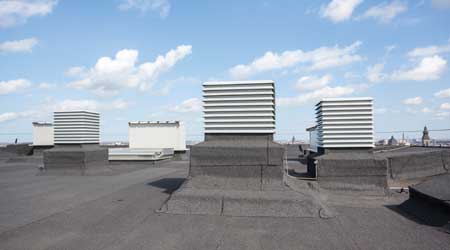 Replacing rooftop equipment, such as HVAC units, must be done carefully under close supervision to prevent damaging the newly installed roof.
Replacing rooftop equipment, such as HVAC units, must be done carefully under close supervision to prevent damaging the newly installed roof.Making Roof Replacements Work
Close attention to roof specification, installation and maintenance can ensure long performance life for a valuable facility component
Maintenance and engineering managers who decide to remove and replace the existing roof face a daunting series of challenges. They must replace a complex system efficiently, deliver a finished project that provides long-term benefits, and, perhaps most importantly, do it all cost-effectively.
To make the business case for investing in such projects, managers need to address a series of key issues during planning, including selecting the most appropriate roof system, addressing common problems that can occur during the installation of a new roof, and ensuring effective post-installation roof inspection and maintenance.
Specification spotlight
Managers who give in to the temptation to replace a roof with the same system might overlook a beneficial opportunity. Roofing system manufacturers are continuously improving their products’ materials and designs, so it pays to do some research to see if new-generation systems offer improvements that fit a particular project.
Some professional engineering help might be the most cost-effective way to tackle this job. One objection managers might run into is that a roof replacement already is expensive, so why add more cost? But expert advice can offset the cost in many ways, including specifications, receiving and evaluating proposals based on a specific set of engineered specifications, evaluating the warranty, selecting a contractor, preparing the job site, overseeing installation, and developing a post-installation maintenance plan that complies with the roof system’s warranty.
In-house specifications might leave out critical components. Differing contractor specifications make comparing one proposal to another difficult and even impossible. Professionals are familiar with all types of roofing, including newer systems with advanced weather protection and better, more energy-efficient insulation. These innovations result in a longer-lasting job and save on heating and air conditioning costs. Engineers also can recommend the best solution for the specific facility, including functional and cost benefits and low-maintenance systems.
Related Topics:















